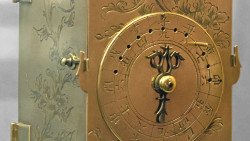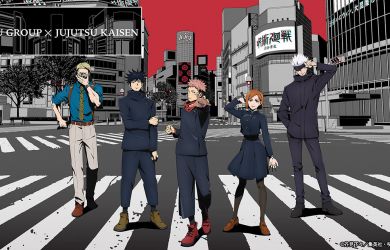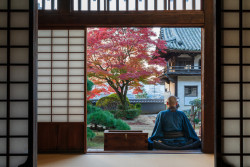
May 27, 2010
Champion Spirit
From the frenetic moves of Dance Dance Revolution to the intellectual intrigue of shogi, local gamers enjoy their piece of the action
By Metropolis
Originally published on metropolis.co.jp on May 2010

Teppei KameyamaCan 'DJ' at the equivalent of 240 words per minutePhotos by Benjamin Park Morin
Teppei Kameyama
Beatmania
Age: 24
Hometown: Ibaraki
Some people play games for the challenge. For Teppei Kameyama, it’s about the experience.
“Music games are different from other video games,” he says. “In other video games, you think about what you’re doing. With Beatmania, you just flow.”
“Flow” is certainly the word that comes to mind as Kameyama’s hands fly across the console. Beatmania puts players in the role of DJ; they must operate a keyboard and turntable in response to instructions that appear on the screen. This sounds simple enough, until you get to Kameyama’s level, where he presses 20 keys a second. That’s the equivalent of typing 240 words per minute—three times the speed of a professional typist and almost as fast as most people read. Yet Kameyama is humble about his achievements.
“Half a year should do it if you try hard, though it took me ten years,” he says, looking embarrassed. “I guess I’m a little slow. But that’s OK.”
Not one for crowds, Kameyama hangs out around the arcades in Akihabara on weekends trying to get as much time in front of the console as possible.
“It’s not that I don’t like people who watch,” he says. “I’m just shy I guess, but if you come and talk to me, I’ll be very happy!”
Kameyama plays on weekends at Tokyo Leisure Land Akihabara #2. 7F Minami Bldg, 4-3-2 Soto-Kanda, Chiyoda-ku (on top of Don Quijote). Tel: 03-5209-5650. Nearest stn: Akihabara.

Ami InadaAspiring pro mahjong player
Ami Inada
Mahjong
Age: 27
Hometown: Kyoto
“I will definitely pass that test!”
The Japan Professional Mahjong League, the largest organization of mahjong pros in the world, will hold its annual acceptance exam this fall. Ami Inada is already pumping herself up for it. Ever since she saw pros playing on TV, she’s aspired to become one herself.
Mahjong is Japan’s most popular table game and can be found in any one of the country’s 10,000 parlors. Most Japanese people learn it to play with their friends or coworkers. For Inada, it was her boyfriend.
“He would play all the time and I couldn’t join him, so I studied the rules without him knowing and one day just sat down at his table. He was pretty surprised,” she says with a laugh. “It was much easier to learn than I thought.”
If Inada passes her test, she will become a shodan mahjong professional.
“I work in entertainment, so this can be part of my brand,” she says. “I think a mahjong professional can attract an interesting audience.”
And what of the boyfriend who taught her mahjong?
“Oh, he’s long gone. I’m in the market for a new study buddy now,” she says with a wink.
For more information about the Japan Professional Mahjong League, see www.ma-jan.or.jp.
[youtube]5fcK7NDQgW4[/youtube]

Shin SasakiDance Dance Revolution perfect score...blindfolded
Shin Sasaki
Dance Dance Revolution
Age: 37
Hometown: Saitama
A small crowd gathers around Shin Sasaki as he steps onto the designated “performer” Dance Dance Revolution machine at the most popular arcade in Akihabara. He turns around to face them.
“Some people say they ‘perform’ dances on this machine,” he says as he gestures to the console behind them. “They are not performers; they are players. I am the performer.”
He then turns back around, ties a blindfold around his head, and executes a flawless dance. The screen flashes “AAA”—a perfect score.
DDR, the original rhythm music game, has been around for over a decade. And it has indeed proved revolutionary—similar games take up entire floors in many Japanese arcades. Players stand on a stage in front of the screen and take visual and musical cues to step, or “dance,” on the specially constructed floor controls. Advanced players memorize the choreography beforehand and perform special moves while they dance. But no one besides Sasaki is good enough to do this blindfolded.
“Other people have tried but they all failed,” he says.
The task is grueling—besides having to memorize hundreds of steps in advance, the player needs perfect timing and balance to execute them all blindfolded. Perhaps it’s not so surprising that Shin can do this—he’s been playing ever since the first DDR console was released in 1998. At 37, he is one of the older champions in Tokyo, but he’s not about to quit anytime soon.
“I plan on performing until my body can’t take it anymore,” he says, removing his blindfold. “Until I choose my successor, there’s only me doing this. I’m here every week.”
Sasaki plays on weekends at Tokyo Leisure Land Akihabara #2. 7F Minami Bldg, 4-3-2 Soto-Kanda, Chiyoda-ku (on top of Don Quijote). Tel: 03-5209-5650. Nearest stn: Akihabara.

Paul Beneder2008 Austrian hanafuda champion
Paul Beneder
Hanafuda
Age: 22
Hometown: Vienna
Paul Beneder tends to confuse his elderly opponents. Not many blond 22-year-olds show up in Tokyo’s shitamachi to play hanafuda.
“First they are surprised because I know how to play the game,” Paul says. “Then they are surprised when I win.”
Hanafuda is one of Japan’s most lovely games. It is played with a deck of 48 traditional paper cards, each bearing the intricate design of a flower and other seasonal elements.
“My favorite is the chrysanthemum and sake cup card.” says Paul, as he twirls it around in his fingers. “It represents the two best reasons to play hanafuda: it’s a beautiful game and it’s fun.”
Beneder has been enjoying hanafuda for close to five years. After learning how to play in his native Austria, he translated the rules into German and English and founded what he believes to be Europe’s only traditional Japanese games club.
“Japan has the best games in the world, and Europeans love games more than anyone else,” he says with a grin. “It’s the perfect match!”
The best place to buy Hanafuda decks in Tokyo is Okuno Karuta. 2-26 Kanda-Jimbocho, Chiyoda-ku. Tel: 03-3264-8031. Open Mon-Sat 11am-8pm, Sun & hols noon-5pm (closed 2nd & 3rd Sun of the month). Nearest stn: Jimbocho. www.okunokaruta.com

Hiromi NakakuraLadies Professional Shogi Association, 2-dan
Hiromi Nakakura
Shogi
Age: 31
Hometown: Tokyo
Don’t let the cute smile fool you—Hiromi Nakakura is one tough cookie.
“I love the taste of competition,” she says with a mischievous grin. “I’ve been playing shogi ever since I was 4. Elementary school students don’t usually get a chance to beat adults. Thanks to shogi, this little girl got to experience the feeling of victory early!”
Nakakura is one of Japan’s few female shogi professionals. Her entire life revolves around the game.
“I’m not good enough to live off tournament winnings alone, so I get involved in other shogi activities,” she says. “I teach lessons, do appearances, and host a weekly show on NHK.”
Played on a 9 x 9 board, shogi is commonly known as “Japanese chess.” In fact, the object is the same as chess—to capture the opponent’s king—but there are several key differences between the games.
“The really interesting thing about shogi is how it reflects Japanese culture,” Nakakura says as she takes a pawn in her hand. “For example, when you capture an opponent’s piece, you add it to your own army. It doesn’t just disappear. This means the game never gets boring; you always have to be on your toes because your former comrade could betray you. The roots of this are in Japanese history.”
For the time being, Nakakura is working on moving up to the next grade—3-dan (there are nine dan in total). And then, she has even more ambitious plans.
“I want to spread shogi all over the world… while riding my Harley!”
The Ladies Professional Shogi Players’ Association of Japan offers regular lessons in Japanese. 2-6-9 Nakazato, Kita-ku. Tel: 03-3915-0931. Nearest stn: Komagome. http://joshi-shogi.com







